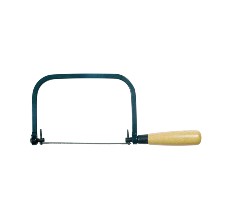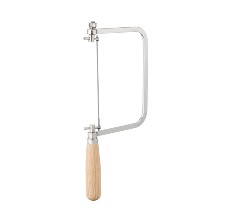Best Coping Saws for Coped Joints
- Robert Larson Coping Saw - Best Overall
- Eclipse Coping Saw - Runner Up
- Bahco Coping Saw - Honorable Mention
- Olson Saw Coping Saw - Contender
- Irwin Coping Saw
A decent coping saw is a tool that is commonly used to cut a variety of forms into molds, including the most difficult ones. It is a typical woodworking tool that’s used for cutting curves. Using a coping saw is not easy, and this equipment lacks accurate cutting capabilities. To avoid issues when using this saw with one hand, you must first choose the appropriate one. This is why selecting the appropriate coping saw is critical. Hence, the top coping saws of 2024 will be analyzed in this guide to save you time and assist you in selecting the best saw. Check out the buying guide and FAQs, too, for further tips and need-to-know information!
Top Coping Saws on Amazon in 2024
Robert Larson Coping Saw
– Best OverallThe fact that this tool is created in Germany is a huge selling point for potential purchasers. Why? Because the products made in this country are frequently built to be lasting, there is a high level of trust in them. This saw, without a doubt, fulfills the promise of duration.
Even when the handle is wood polished, it has a solid metal structure that lasts years of constant use. The advantage of the tool blade is that it is simple to adjust the tension, making it quick and easy to use. When the blade wears out, it can easily be replaced with a tool that accepts normal saw blades.
- Simple to change the tension to any angle, giving you the optimum approach to your work
- Ordinary blades are utilized by this coping saw
- The handle is not flexible
Eclipse Coping Saw
– Runner UpEclipse’s coping saw is a fan favorite due to its strong frame, which helps the saw slices= through wood and other trim materials flawlessly. It has a blade that is extra sharp. The tension may be easily adjusted. While several reviews praised it for its trim work, it’s also excellent for creating desks and tables, and it lasts for years.
This saw tightens the blade, turns like a dream, and is simply a joy to use. You can utilize it for a variety of tasks that would normally need a gent’s or dovetail saw.
- The blade is almost indestructible and provides excellent cutting performance
- Cut complicated external forms and inner cut-outs using this tool
- Not ideal for hardwood
Bahco Coping Saw
– Honorable MentionThe BAHCO saw has a nickel-plated steel frame, which combines steel’s durability with nickel’s rust-resistant qualities. Because some types of stainless steel can’t be heat processed for optimum toughness, treating a heat-treated metal frame with nickel creates a robust, corrosion-resistant saw. Among the most resilient coping saws on the marketplace, this combination is an obvious success. It serves as a reliable blade.
One major flaw with this model is the orange plastic handle, which makes it appear to be a low-cost tool.
- Features simple and quick blade changes
- The grip is easy to hold
- The blade is not properly aligned
Olson Saw Coping Saw
– ContenderThis is a lightweight saw that you’ll want to keep in your workspace. This coping saw is quick and simple to operate. It comes in a package with 5 blades, but only one could be used at a time to cut, with the others acting as reserve.
Even though the blades are extremely strong and difficult to break, this happens on a frequent basis. The blade replacement technique is simple and quick. Gently detach the two screws to remove the dull blade and install a new one to finish the task. The handle of this tool is constructed of a mix of wood and light steel.
- Allows tensioning of both ends of traditional coping saw blades
- Blades may be rotated 360 degrees in order to saw in any direction
- For some folks, the handle is too small
The IRWIN Tools Pro Touch has one of the largest depths of any coping saw on the market. It also comes with a blade that has 17 teeth per inch rather than the conventional 14, allowing for faster, easier, and more precise cuts. It’s also one of the most affordable options on the list, so you get all of these features for a fraction of the cost of the others. It features a sturdy steel frame, but it hasn’t been treated or nickel-plated, so it will corrode with time. It also has an ergonomic plastic grip that is more comfortable to use but less sturdy in the long run.
- Due to its steel-based construction, it is extremely durable
- The blade is simple to modify and replace
- Blade holders break after wear
Best Coping Saws Buying Guide
Although many companies may say that their product is the best one available, you must still conduct your research since there is no certainty that the product is built for you and your difficult assignments in mind. As a result, we strongly advise that you conduct extensive research to establish which coping saw is truly the one for you and which ones you should avoid.
There are numerous elements of these saws that you should consider, and we will go over each one in detail to help you make a decision when buying a coping saw to assist you with your woodworking job.
What Are the Factors To Consider While Buying a Coping Saw?
Blade installation
The most crucial part is the installation of saw blades. A gear is mounted to either end of the socket on most blades. If you’re cutting wood with the saw, the clip will keep the saw blade from slipping.
Rotation of the blades
What is the speed (and accuracy) of the blade rotation? Without detents, any coping saw cannot be considered the best coping equipment.
Quality of the blades
Another important element to look for and consider when purchasing a coping saw is blade quality. Bimetallic blades are used in several saws. Carbon steel blades are used in some. The blade base is made of steel that has the appearance of a lighter metal but is still flexible.
Materials
It is possibly one of the most important characteristics to consider when purchasing a saw because it will eventually determine the overall quality of the tool-making process.
Although other elements have an impact on the smaller structures involved, the quality of the workmanship is usually used to determine the stresses that the coping saw can withstand. In this situation, a coping saw with high-quality metal for the frame and portions outside the handle will suffice.
What Are the Features To Look For in a Coping Saw?
Throat
The throat of a coping saw is the space between the blade and the frame, and it plays an important part in deciding the sort of project and spaces the saw can work on.
This isn’t just a case of “larger is better,” because a narrower throat allows you to cut more effectively in tight locations. Given how frequently pipe saws are used, this can save real-time in the correct circumstances. However, you should always go ahead and acquire the best saw for the job.
Connection
There are several different sorts of saw linkages, but one is far more prevalent than the others. The most common sort of coping saw is one with a spindle shape and two gears integrated into the cutting mechanism at the blade’s end.
Most coping saws are equipped with blade tensioning systems, but this is not always the case. The alternative way necessitates the use of a spindle mechanism and the use of open hand blades in power transmission saws.
Tension
A coping saw has a thin blade, that must be kept under suitably high tension. Some saws have a tensioning device that spins outside the frame to modify the frame angle. The blade tension can usually be adjusted from the mounting pins on most coping saws, however, this can be a little more complicated.
Ergonomics
While it may not appear attractive, ergonomics is critical if you plan to utilize it for a significant number of tasks. Turning on the ergonomic handle is another technique to make it easier to use a saw for longer periods of time.
What Are the Different Types of Blades Used in Coping Saws?
Wood
To cut through wood, use a coarse blade with 15 TPI (Teeth per Inch) or less, as it eliminates the material rapidly and gives you a straight cut line. When it comes to cutting wood, coarse blades are usually sufficient. If you need to cut along curved lines, though, you’ll need blades with more than 18 TPI, but keep in mind that they’ll be slower.
Stainless steel
Cutting metal requires a strong blade made of high-carbon steel, which will enable you to slice through non-hardened metal with ease.
Plastic
We propose using a helical teeth blade to cut through the plastic with ease. They aren’t particularly fancy, but they are excellent for this type of cloth.
What’s the Point of Using a Coping Saw?
Coping saws are useful in a few situations where they are the best instrument for the job. It’s one of the greatest tools for cutting holes inside a solid block of wood, for example. Because a coping saw’s blade is easily detachable, all you have to do is drill a hole in the middle of the object, insert the blade, and reconnect the frame. The hole can then be expanded and turned into a design in the wood’s middle. Cutting a design into the back of a wooden chair, such as a heart or a star, is one example.
While a coping saw may be a decent woodworking tool, working with it may be a little challenging especially if you are new to woodworking. Check the video from Paul Sellers that addresses common questions that most people have while working with them.

People Also Asked
Coping is the top course of a brick or stone wall, which is often curved or sloping. As a result, this has become the term for curved finishes on wooden things, such as skirting. The wood is then coped to meet the curvature using a coping saw!
This is determined by the frame's size. You won't be able to go much deeper once you've cut to the depth of the frame because the thing you're cutting will block you.
They're best for cutting complicated forms and matching corners for beautiful miters. They're frequently seen on skirting boards.
The Woodsmith Review Team’s product reviews and in-depth guides are here to help you choose the best tools and gear to build great-looking projects confidently. Woodsmith is reader-supported: When you buy through links on our site, we may earn an affiliate commission. Large language models (like Artificial Intelligence) may have been used in the research and creation of the content.
Inquiries regarding specific articles or product testing should be sent to aimperiapt@gmail.com





